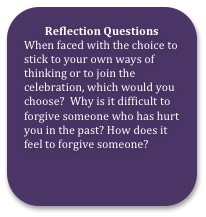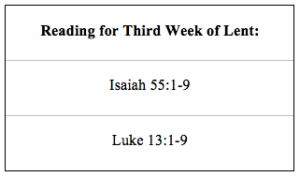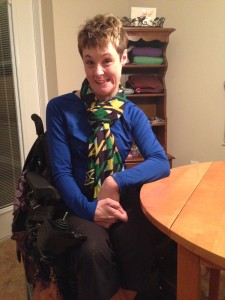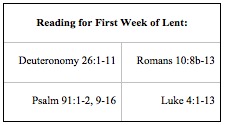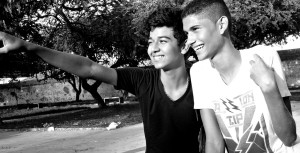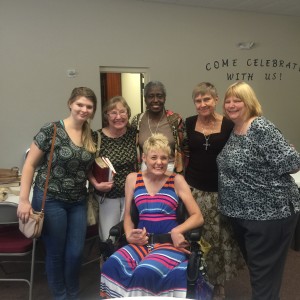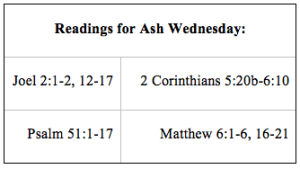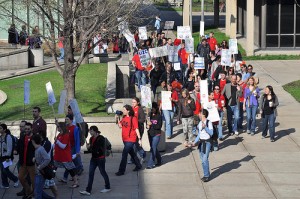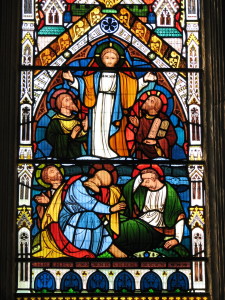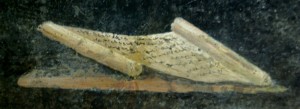Disability theology interprets the biblical stories through the experiences of individuals with disabilities—broken bodies in one form or another—and examines the relationship between God and individuals with disabilities.

Screenshot 1.1 from dictionary.reference.com
According to Dictionary.com, disability means “anything that disables or puts one at a disadvantage.” If this is true, then anyone can be disabled at any time. For example, a person who is sick with a cold could be considered to be disabled. The disabled minority is unique; it is the only minority that a person can join or leave at any stage of their lifetime. Without warning, an individual can become disabled in a car, diving, or any other accident. A person who breaks their foot is considered to be disabled, according to the DMV, and is eligible to apply for a temporary handicap permit. (For a full list of what qualifies for a temporary handicap permit, see screenshot 1.2 below.)
The Church says humans are naturally broken as a result of
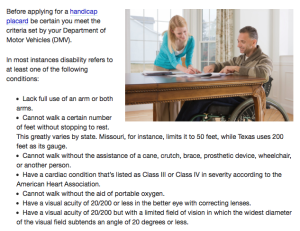
Screenshot 1.2 from DMV
Adam and Eve eating the forbidden fruit in the Garden of Eden, an action which introduced sin into the world. As Christians, we are disabled by our inability to have a perfect relationship with God the Father without the intervention of Jesus Christ dying on the cross for the forgiveness of our sins. If we use this definition of disability, then as Christians, we can conclude that anyone is disabled to varying degrees at any given moment.
Beyond this spiritual definition, disabilities range from physical to psychosocial and can be a mixture of the two. Examples of physical disabilities are a limp, Parkinson’s disease, being paralyzed and being in a wheelchair, blindness or poor eyesight, or anything that puts a physical limitation on a person. Examples of psychosocial disabilities are depression, anxiety, post-traumatic stress disorder, traumatic brain injury, or learning disabilities, such ADHD or dyslexia. Psychosocial disabilities are harder to get diagnosed and are often called invisible disabilities, because they are not immediately seen by the public. An individual can have one or multiple disabilities; either situation gives them a unique perspective on life. By listening to the voices of individuals with disabilities, we are able to reimagine the biblical stories in new and surprising ways, which allows us to open our hearts and minds to people who are different from us.[i] This allows Christian communities and churches to open their doors to individuals with all abilities by being mindful of a broad spectrum of the human experience.
Within the Christian tradition, people with disabilities are often viewed as defiled individuals or spiritual superheroes—divinely damned or divinely blessed.[ii] Jesus seems to use the both/and explanation: disability can be a way to bring glory to God the Father, and disability can be caused by sin. In John 9, the healing of the blind man happens in order to bring glory to God the Father (John 9:1-3). This provides the Lord a way to bring his presence into our lives. In Luke 5:18-23, Jesus heals a paralyzed man and asks, “Which is easier, to say, ‘Your sins are forgiven you,’ or to say, Stand up and walk’?” (Luke 5:23 NRSV). Here the disability is linked to sin, and the healing is linked to the forgiveness of the sin. In both cases, the end result is the same: the individual is transformed from the healing, and it renews their relationship with God the Father.
Throughout history, theologians have been working on developing a theology of disability; Martin Luther, Karl Barth, and Dietrich Bonhoeffer are theologians who contemporary theologians look to when discussing disability theology. Nancy L. Eiesland and Deborah Creamer are both well-known contemporary theologians who have helped develop the disability theology field.
Martin Luther is known for nailing his Ninety-Five Theses to the door of the Castle Church of Wittenberg on October 31, 1517; this was the catalyst for the Protestant Reformation. According to Martin Luther and his theology of the cross, individuals cannot be perfect in God’s eyes, because Adam and Eve introduced “the Devil, sin and death” into the world. People are not able to construct their own ethical guidelines, but God gives them the Ten Commandments. God also frees humans through Jesus’s crucifixion, death, and resurrection and gives us eternal life in the kingdom of God, if we believe in Jesus and the power of the cross. People with disabilities are able to be mediums of God’s message, making it known to others according to their gifts and abilities. The hope is for humans to change how they see people with disabilities and to wonder how God’s message is being shared and expressed by people with disabilities.[iii]
Karl Barth developed his theology of disability through his friendship with Heinrich Vogel; Vogel’s daughter was physically disabled. Although the conversation is not confirmed to have happened, it is said that Vogel thought his daughter would walk in God’s new creation, whereas Barth thought Vogel’s statement (she will walk) meant God made a mistake, and that her earthly life was not productive. Barth goes on to say Vogel’s daughter would be at the head of the table, while if granted a seat, they would be at the other end.[iv]
According to Barth, humans are created by God and exist for God, and therefore, God is the giver of life. Our identity comes from God who created us. Sin is our refusal to grace and our resistance to both the Creator and our own identity as created beings. God gifted human beings the ability to reason, to think and know, and to react to events and the actions of others. God is able to relate to each one of us differently, and these differences are only known by him; he decides what, when, and how he shares certain information with us.
Barth believed life is a divine gift that we should receive in wonder and modesty and that should be respected and confirmed by ourselves and others; it is only temporary and is not promised. Jesus is a man for God who called upon his son for a unique service. Jesus is a man for others, who lived with others by affirming their lives, enjoying their presence, and honoring them. Jesus is a whole man, who was fully human, who encountered God and others in the world. Jesus is Lord of time and lived in the world at a specific time and place, with all their limitations. Using Jesus as an example, then, people are to live the life God gives them on his terms. Therefore, since Jesus served the sick, the disabled, the poor, the hungry, the homeless, and the sinner, we are to serve others as he served us by supporting and protecting one another, especially those who cannot help themselves. People need to live the life God has given them, no matter what. The Church becomes a place where the able and the disabled are shown mutual respect and are affirmed and made holy, comforted and supported by the community.[v]
Dietrich Bonhoeffer was a theologian who dedicated his vocation to serving and protecting the disabled. His theology for the disabled developed when he visited Bethel, Germany in 1933, a place where the mission of the community was to care for the weak and fragile. Unfortunately, Bonhoeffer lived under the dictatorship of Hitler’s Germany, characterized by a man who set out to create a superhuman race. The Nazis created the expression “mercy death” and promoted the subjective notion of “life not worth living” if objective healthcare costs out weighed the quality of life, which is the argument used by advocates of assisted suicide. Bonhoeffer disagreed with this line of thought, especially after his visit to Bethel.[vi]
Bonhoeffer waged war against the Nazis’ ideology by preaching support and care for those who were sick and fragile. If you spend any time with the disabled, then you will grow to understand that personal suffering is more important than personal happiness, because you learn what truly matters in the world. Through sickness and suffering, people are able to grow in their insight of life. Furthermore, when able people welcome people with disabilities into their lives, able people are forced to realize how frail and mortal any human life is, in reality. Bonhoeffer taught that Christ came into the world to suffer and die on the cross; as Christians, we share in his suffering, which enables us to embrace his grace and love.[vii] All humans, able and disabled, are worthy of God’s forgiveness, love, and grace.
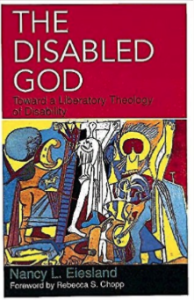
Screenshot of book from Amazon.com
In the mid-1990s, Nancy L. Eiesland became a well-known theologian in her field after writing The Disabled God: Toward a Liberatory Theology of Disability. Eiesland believes God is disabled based on her reading of Luke 24:36-39 where Jesus has his disciples touch his wounds. She writes, “The disabled God emerges in the particular situation in which people with disabilities and others who care find themselves as they try to live out their faith and to fulfill their calling to live ordinary lives of worth and dignity.”[viii] If people with disabilities are able to imagine God as being disabled, then they are able to see themselves in the image of God, which enforces the important truth that they are a part of God’s good creation.
Deborah Beth Creamer’s book Disability and Christian Theology: Embodied Limits and Constructive Possibilities evaluates what it means to be an embodied creature of God within the Christian church tradition. For Creamer, the categories of disabled and able are absolute. Creamer writes, “The term ‘disability,’ as it is commonly used, is an absolute category without levels or thresholds. One is either disabled or not. From this perspective, ‘one cannot be a little disabled any more than one can be a little pregnant.’”[ix] Some individuals are able to fit in both categories and find others deciding which camp they should be in at different times. Creamer points out limits are a part of everyone’s lives. Creamer writes, “When we dismiss disability as being an exceptional and othering experience, we deny the normality of limits in all of our lives, pretend that we do not experience increasing limits as we age, and even refuse to acknowledge the future limit of death.”[x] It is inarguable that we will experience being disabled at one point or another, if only at our deathbed. People, able and disabled alike, experience limits on their abilities on a daily basis, which makes disability a communal experience and not an individual, exceptional experience. Even without cerebral palsy, I experience a limit to my physical reach, due to being only five-foot-one-inch tall. Limits are an embodied, universal experience.
My experience as an individual who has cerebral palsy and as an observer of others with disabilities has helped me to develop my own personal theology of disability. By being in community with others who have disabilities, I have come to understand that everyone has some kind of disability, even if it is just being physically too short or too tall, as silly as it sounds.
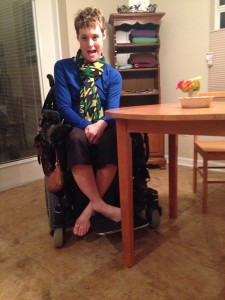
Photo credit: Samantha Lynn Parker
As I have shared in past devotions, people in public seem to think something is wrong with me or that I am broken simply because I cannot walk or talk clearly. As stated earlier, the Church often views people with disabilities as defiled individuals or spiritual superheroes—divinely damned or divinely blessed. If the disabled body is broken, and human beings are broken due to the Fall (Genesis 3), then everyone has a disabled body, because no one is without sin or has the perfect body. No one can live fully independently without the help of anyone. For starters, we do not ourselves to be born into the world, but God creates each one of us and entrusts our parents to tend to our needs. We all rely on the services and work of others to survive in the world.
Theology of disability is not just for people who are labeled as disabled but for anyone and everyone who has experienced a setback in their life or a temporary or permanent limitation. Theology of disability is messy; it brings up our individualized brokenness and the things we try our best to hide from the public eye. However, if we start naming our brokenness, not out of resentment but out of willingness to embrace our true selves, maybe then we can experience a resurrection in our own lives and embrace one another’s abilities and gifts. In community, we lament what is broken or lost and lift each other up in prayer. In community, we come together to share in the brokenness of the world and to become whole through God’s actions on our behalf. In community, we learn what it means embody God’s creation in the world.
[i] John Swinton, “A Disability Homiletic: Opening the Church to the Fullness of Our Humanness,” Journal for Preachers 39, no. 2 (2016): 13.
[ii] Nancy L. Eiesland, The Disabled God: Toward a Liberatory Theology of Disability (Nashville: Abingdon Press, 1994), 70.
[iii] Stefan Heuser, “The Human Condition as Seen from the Cross: Luther and Disability,” in Disability in the Christian Tradition: A Reader, ed. Brian Brock and John Swinton (Grand Rapids: William B. Eerdmans Publishing Company, 2012), 191, 193.
[iv] Donald Wood, “This Ability: Barth on the Concrete Freedom of Human Life,” in Disability in the Christian Tradition, 392.
[v] Ibid., 394-97.
[vi] Bernd Wannenwetsch, “‘My Strength is Made Perfect in Weakness’: Bonhoeffer and the War over Disabled Life,” in Disability in the Christian Tradition, 354-55, 359.
[vii] Ibid., 356, 361, 363.
[viii] Nancy L. Eiesland, The Disabled God, 98.
[ix] Deborah Beth Creamer, Disability and Christian Theology: Embodied Limits and Constructive Possibilities (New York: Oxford University Press, 2009), 6.
[x] Ibid., 119.

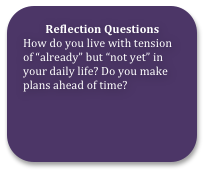
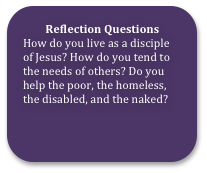 before he explains it (John 14:2-4; 16:19-24). Mary anoints Jesus out of love and devotion. Mary’s act demonstrates what discipleship looks like. Discipleship is the pouring out of your love for God and Jesus Christ into the world. It is the kind of selflessness that will also work later to help the poor, the homeless, the disabled, and the naked. Mary shows her devotion to Jesus by giving of herself in his time of need.
before he explains it (John 14:2-4; 16:19-24). Mary anoints Jesus out of love and devotion. Mary’s act demonstrates what discipleship looks like. Discipleship is the pouring out of your love for God and Jesus Christ into the world. It is the kind of selflessness that will also work later to help the poor, the homeless, the disabled, and the naked. Mary shows her devotion to Jesus by giving of herself in his time of need.
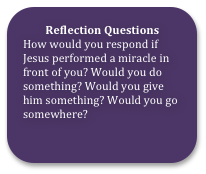 will need clothes; others will need food and water; others will need prayers. The world is a needy place where someone will always need something. However, Jesus was not to always be physically present in the world. Mary is taking the opportunity to express her devotion and love for Jesus—the one who brought her brother back to life, the one who has healed so many, the one who has taken care of the poor, and the one who will die for our sins. Mary does the one thing she can do for Jesus—anoint him for burial.
will need clothes; others will need food and water; others will need prayers. The world is a needy place where someone will always need something. However, Jesus was not to always be physically present in the world. Mary is taking the opportunity to express her devotion and love for Jesus—the one who brought her brother back to life, the one who has healed so many, the one who has taken care of the poor, and the one who will die for our sins. Mary does the one thing she can do for Jesus—anoint him for burial.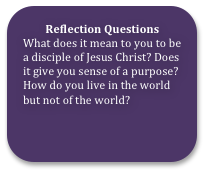 Jesus gave up himself for the sake of our sins. We acknowledge our brokenness and our need for Jesus to die on the cross, so we can be in relationship with God the Father, God the Son, and God the Holy Spirit.
Jesus gave up himself for the sake of our sins. We acknowledge our brokenness and our need for Jesus to die on the cross, so we can be in relationship with God the Father, God the Son, and God the Holy Spirit.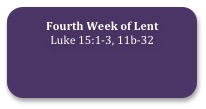

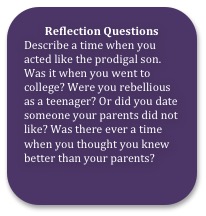
 lifestyle. The text does not tell us what the prodigal son did exactly, but we can imagine what kind of trouble a young man could get into. If we set the parable in modern times, the prodigal son probably would be doing drugs and/or drinking to excess, buying expensive toys, paying for sex, getting in trouble with the law, or [whatever “it” is] that he wanted.
lifestyle. The text does not tell us what the prodigal son did exactly, but we can imagine what kind of trouble a young man could get into. If we set the parable in modern times, the prodigal son probably would be doing drugs and/or drinking to excess, buying expensive toys, paying for sex, getting in trouble with the law, or [whatever “it” is] that he wanted. loyal and committed to him, for making his life on the family farm, and for caring for him as he ages. The older son has been with the father the whole time—making memories, learning the family business, and growing the family. The father is extremely grateful for his older son, yet he mourns the loss of his younger son—the prodigal son. The father misses spending time with the prodigal son. By taking his inheritance and moving away, the prodigal son robs his father of making memories with him, of teaching him the family business, and of watching his grandchildren grow up. The father’s heart aches to know the prodigal son personally, to know he is safe and healthy, and to watch him grow into a man. It is devastating for any parent to have a child run off and to have no contact with them. Not all of us are parents, but we all of us have experienced being wronged by someone who we should have been able to trust.
loyal and committed to him, for making his life on the family farm, and for caring for him as he ages. The older son has been with the father the whole time—making memories, learning the family business, and growing the family. The father is extremely grateful for his older son, yet he mourns the loss of his younger son—the prodigal son. The father misses spending time with the prodigal son. By taking his inheritance and moving away, the prodigal son robs his father of making memories with him, of teaching him the family business, and of watching his grandchildren grow up. The father’s heart aches to know the prodigal son personally, to know he is safe and healthy, and to watch him grow into a man. It is devastating for any parent to have a child run off and to have no contact with them. Not all of us are parents, but we all of us have experienced being wronged by someone who we should have been able to trust.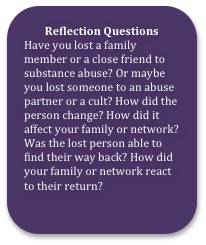 abuse, they experience similar emotions as the father in the parable. Anyone who struggles with substance abuse is taken away from their family by the chosen drug of choice, because it changes their behavior and makes them dependent on it. However, sometimes the individual is able to go into rehab and remain clean. When this happens, the individual is able to return home and renew their relationships with family members. I remember rejoicing with my mom when my brother went into rehab for substance abuse, and every year we rejoice he has remained clean and has a steady job. We rejoice every time we are able to have a conversation or take a trip with my brother, because if he had kept doing drugs, he may not have been here today. My brother was lost, but now he is found.
abuse, they experience similar emotions as the father in the parable. Anyone who struggles with substance abuse is taken away from their family by the chosen drug of choice, because it changes their behavior and makes them dependent on it. However, sometimes the individual is able to go into rehab and remain clean. When this happens, the individual is able to return home and renew their relationships with family members. I remember rejoicing with my mom when my brother went into rehab for substance abuse, and every year we rejoice he has remained clean and has a steady job. We rejoice every time we are able to have a conversation or take a trip with my brother, because if he had kept doing drugs, he may not have been here today. My brother was lost, but now he is found.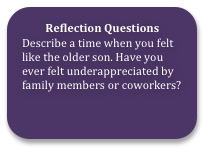 father is celebrating over his brother, who wasted his inheritance on foolishness things, while the older son never left his father’s side and worked hard to maintain the family business. And yet, the older son has never gotten a celebration (Luke 15:29-30). The older son feels underappreciated.
father is celebrating over his brother, who wasted his inheritance on foolishness things, while the older son never left his father’s side and worked hard to maintain the family business. And yet, the older son has never gotten a celebration (Luke 15:29-30). The older son feels underappreciated.